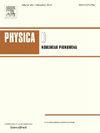Influence of coupling symmetries and noise on the critical dynamics of synchronizing oscillator lattices
IF 2.7
3区 数学
Q1 MATHEMATICS, APPLIED
引用次数: 0
Abstract
Recent work has shown that the synchronization process in lattices of self-sustained (phase and limit-cycle) oscillators displays universal scale-invariant behavior previously studied in the physics of surface kinetic roughening. The type of dynamic scaling ansatz which is verified depends on the randomness that occurs in the system, whether it is columnar disorder (quenched noise given by the random assignment of natural frequencies), leading to anomalous scaling, or else time-dependent noise, inducing the more standard Family-Vicsek dynamic scaling ansatz, as in equilibrium critical dynamics. The specific universality class also depends on the coupling function: for a sine function (as in the celebrated Kuramoto model) the critical behavior is that of the Edwards-Wilkinson equation for the corresponding type of randomness, with Gaussian fluctuations around the average growth. In all the other cases investigated, Tracy–Widom fluctuations ensue, associated with the celebrated Kardar–Parisi–Zhang equation for rough interfaces. Two questions remain to be addressed in order to complete the picture, however: (1) Is the atypical scaling displayed by the sine coupling preserved if other coupling functions satisfying the same (odd) symmetry are employed (as suggested by continuum approximations and symmetry arguments)? and (2) how does the competition between both types of randomness (which are expected to coexist in experimental settings) affect the nonequilibrium behavior? We address the latter question by numerically characterizing the crossover between thermal-noise and columnar-disorder criticality, and the former by providing evidence confirming that it is the symmetry of the coupling function that sets apart the sine coupling, among other odd-symmetric couplings, due to the absence of Kardar–Parisi–Zhang fluctuations.
耦合对称性和噪声对同步振荡器晶格临界动力学的影响
最近的研究表明,自维持(相和极限环)振子晶格中的同步过程显示出先前在表面动力学粗糙化物理学中研究过的普遍尺度不变行为。被验证的动态标度分析的类型取决于系统中发生的随机性,无论是柱状无序(由自然频率随机分配给出的猝灭噪声),导致异常标度,还是时间相关噪声,导致更标准的Family-Vicsek动态标度分析,如平衡临界动力学。特定的普适性类还取决于耦合函数:对于正弦函数(如著名的Kuramoto模型),其临界行为是对应类型的随机性的爱德华兹-威尔金森方程,在平均增长周围有高斯波动。在所有其他被调查的情况下,特雷西-威登波动随之而来,与著名的卡尔达-帕里西-张粗糙界面方程有关。然而,为了完成这一图景,仍有两个问题有待解决:(1)如果采用满足相同(奇数)对称性的其他耦合函数(如连续统近似和对称性参数所建议的那样),则正弦耦合所显示的非典型尺度是否保留?(2)两种随机性之间的竞争(在实验环境中预期共存)如何影响非平衡行为?我们通过数值表征热噪声和柱状无序临界之间的交叉来解决后一个问题,而通过提供证据证实,由于没有kardar - paris - zhang波动,耦合函数的对称性将正弦耦合与其他奇对称耦合区分开来,从而解决前者问题。
本文章由计算机程序翻译,如有差异,请以英文原文为准。
求助全文
约1分钟内获得全文
求助全文
来源期刊

Physica D: Nonlinear Phenomena
物理-物理:数学物理
CiteScore
7.30
自引率
7.50%
发文量
213
审稿时长
65 days
期刊介绍:
Physica D (Nonlinear Phenomena) publishes research and review articles reporting on experimental and theoretical works, techniques and ideas that advance the understanding of nonlinear phenomena. Topics encompass wave motion in physical, chemical and biological systems; physical or biological phenomena governed by nonlinear field equations, including hydrodynamics and turbulence; pattern formation and cooperative phenomena; instability, bifurcations, chaos, and space-time disorder; integrable/Hamiltonian systems; asymptotic analysis and, more generally, mathematical methods for nonlinear systems.
 求助内容:
求助内容: 应助结果提醒方式:
应助结果提醒方式:


